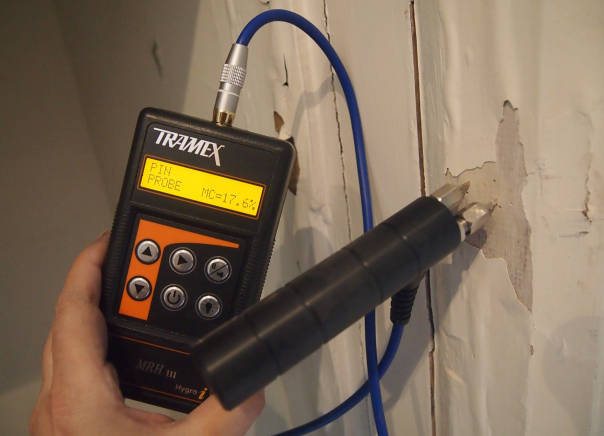
I can’t imagine that I’ll be doing a lot of product reviews through this blog and just to declare any interests, I was recently handed a Tramex MRH III to try out. I actually said at the time that I’d write a review but if I didn’t like it then I didn’t like it… Tramex didn’t seem worried and the brand certainly isn’t new to me, I already own a concrete moisture encounter and a Hygrohood. The Hygrohood in particular is a far better product than its nearest competitor, which I also own. Tramex is one of those brands that doesn’t seem to have quite broken through in the UK but they’re incredibly popular in the states. The market in professional damp meters in the UK seems to be cornered by Protimeter and has been for a number of years. Indeed, most of my equipment is Protimeter. I have a Surveymaster, a Protimeter mini and a Hygromaster, all of which I have used for a number of years.
When you use this equipment as often as I do then you can get very comfortable both with the feel of the equipment and your own interpretation of results. I wrote a damp investigation process based on relative readings obtained from using the Protimeter in pin mode so that if pin readings of 20R/R (Relative reading) or above are obtained at surface or using deep wall probes then the investigation moves to the next stage. Therefore one of my key questions was with regard to what meter reading on the Tramex MRH III would equate to the 20 R/R reading on the Protimeter. Also how quickly would I get comfortable in using this equipment and interpreting results?
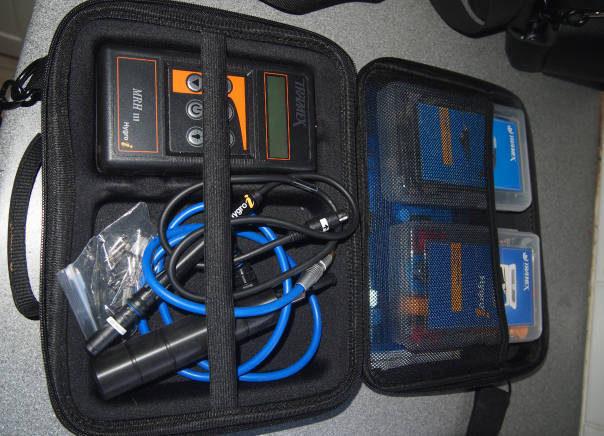
I’m also interested in any available calibration process, particularly as it relates to the humidity probe because I’ve not previously had the ability to check the accuracy of my Protimeter humidity probes and have simply renewed them occasionally to pre-empt any potential issues of inaccuracy. The MRH III came supplied with this clever Hygro i calibration device. Essentially this is a vessel filed with salt and water that cleverly maintains the internal environment at 75%. This isn’t a portable device, you’re meant to leave it in the office and occasionally take your meter in to check calibration. I though this was a big plus and in fact it even allowed me to check calibration on my Hygromaster which read 73.6% RH when tested with this calibration device. On paper, the MRH III does just about everything that you would want a professional moisture meter to do, it is a Hygrometer, a non-destructive scan meter, a pin probe meter for taking surface moisture readings with a second attachment for using deep wall probes in pin probe mode. Scan mode switches between a number of modes, roof, masonry, drywall, wood and laminate; all fairly self explanatory. However what I found when using the various modes is that this meter is incredibly versatile and far more informative than the Surveymaster I am currently using.
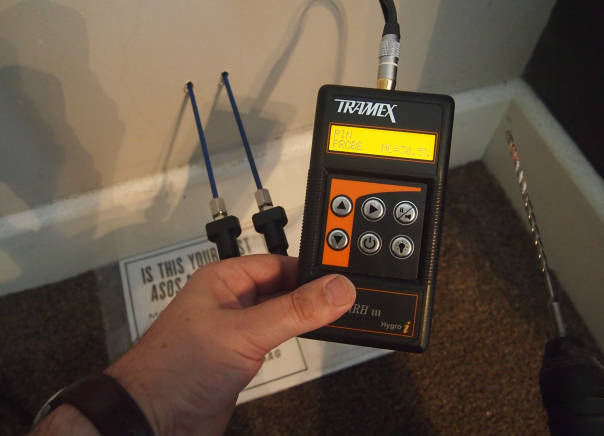
Drywall mode has a much deeper scan facility than the survey master, which is fairly useless on stud walling. I was surveying a property where a number of damp walls had been hidden behind dry lining and the MRH III gave a clear indication that the hidden walls were damp. This was confirmed (relatively speaking) with deep wall probes. You are immediately struck by the excellent build quality of this equipment and the robustness of the attachments. Electrical leads look like high quality gold plated phono leads and the deep wall probes made the Protimeter version look poor by comparison. Indeed I have had a number of problems with the leads separating from the ends of the Protimeter probes but you just can’t imagine that happening with the Tramex version. For surface readings the MRH III doesn’t have the traditional arrangement of pins protruding from the end of the meter. Instead there is another high quality attachment that is quickly attached. I carried out a number of readings with this pin probe attachment and compared them to readings obtained with the Protimeter and interestingly what I found is that relative readings mirrored one another up to around 30%. At this point we started to see divergence between the readings obtained. The Protimeter threw in the towel and generally read off the scale whilst the Tramex didn’t.
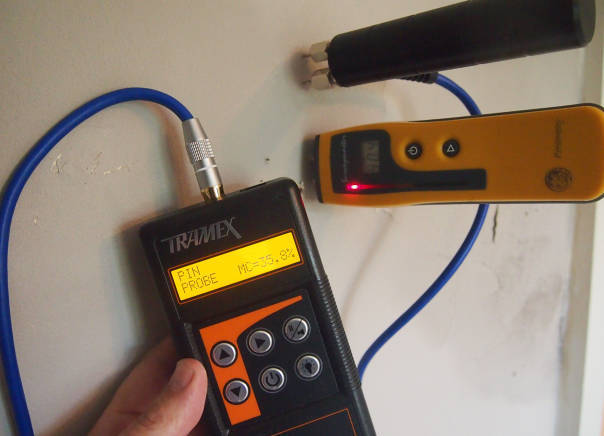
The Tramex became far more controlled and gave qualitative readings throughout the relative scale reading up to 100%, whilst the Protimeter just read off the scale and gave no real qualitative results beyond the fact that the wall might be very damp. There is no real mid-range and tendency to read off the scale at high levels and a good analogy might be that It’s similar to conversing with someone who can only whisper or shout. In the adjacent image you can see where the Tramex was showing a qualitative result of 35.8% where the Protimeter was pretty much reading off the scale. This was a general problem with the Protimeter, that once a certain level of moisture was reached, the Protimeter simply read off the scale thereby reducing the ability to interpret results. I spent a day comparing results and also comparing the Tramex relative readings to total moisture contents obtained from calcium carbide testing and I found that it was far better controlled and had a far better data range than the Surveymaster. Arguably this is the older Surveymaster and there is a face lifted MK II version and I’m unsure if there were any internal modifications made to the electronics. My understanding is that this was purely an aesthetic change to the casing and I saw no reason to upgrade to the Mk II at the time they were released.
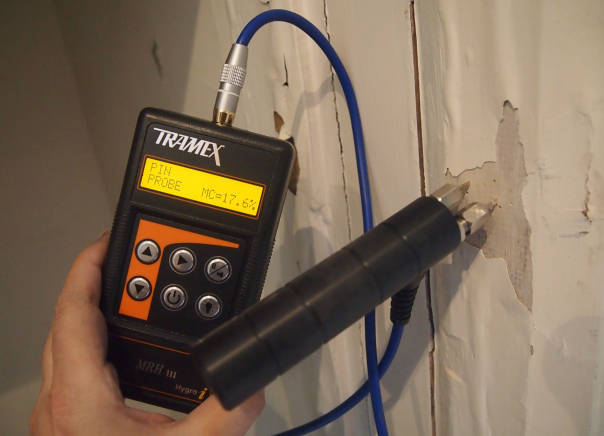
When checking timber moisture content I found that the Tramex and Surveymaster mirrored each others readings almost exactly which was comforting but the Tramex does provide the ability to adjust for timber species when used in scan mode. A function that I’ve not fully explored yet. In one kitchen wall I tested a wall base using the MRH III in scan mode and received a Medium dampness reading of 57. The wall was affected by mould colonisation due to cold surface condensation and I’d also previously obtained high surface readings in pin probe mode of 31%. Interestingly when testing the wall moisture content at depth with calcium carbide I recorded a reading of 0% proving that the wall was dry but the plasterwork was damp due to chronic condensation. This appears to indicate that when obtaining only medium damp readings in scan mode that only the plasterwork is damp and not the underlying masonry but again, readings can depend on the density and type of plaster installed but more testing will help me gain that confidence in interpreting results and getting a generalised feel for how it performs. Of course as with all electronic moisture meters, there will always be anomalies that throw up false positive readings, the presence of salts or carbonaceous materials will cause a false positive reading but so long as you do not rely 100% on these meters for diagnosis then this is not a major issue.
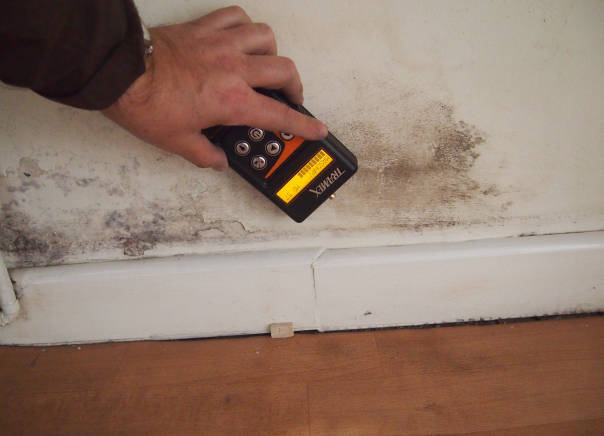
A condensation risk assessment was also carried out using the Tramex in Hygrometer mode and I had the comfort of knowing that the probe was calibrated and the relative humidity readings were accurate. Similar to the Protimer Hygromaster, the MRH III also has an option for using hygro sleeves to take ERH readings in floors or walls. It’s useful that sizes of the sleeves appear to be standardised at 16mm. The Hygro probe attached with a multi plug connector and again this is a simple and quick connection and I noted that the meter immediately switches to Hygro mode once connected. Readings can be easily seen with or without the backlight function, which is a useful option.
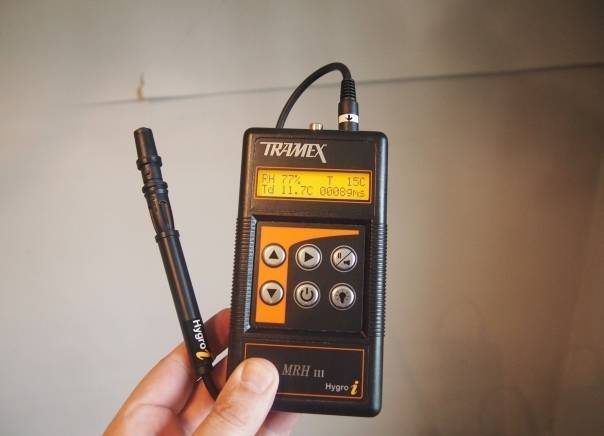
I possibly haven’t fully assessed the capability of this unit yet but even at this stage I am completely won over by its versatility and build quality; it feels like a professional & durable piece of kit and I am already favouring its use over the Surveymaster because it is far more controlled across a broader scale of moisture content and gives me a wider range of options. Of course this replaces two tools currently in my diagnostic kit, the Surveymaster and the Hygromaster. Chartered professionals have always tended to favour the Protimeter and for those wanting something to carry in their pocket perhaps that will continue but the bare MRH III will fit in your coat pocket if you only want to use the meter in scan mode, and to be frank, if you only ever use a damp meter in scan mode, as some valuation surveyors do, then this is gives a far better range of scanning options than the Protimeter equivalent.
From my perspective, this a serious piece of kit that should be considered by any serious damp investigator and suddenly my Protimeter equipment doesn’t feel quite as professional as it once did, when compared to this Tramex equipment. I’ve forgiven my Protimeter equipment for a number of niggly flaws, the cap constantly falling off the Surveymaster, poor electrical connections on the Hygro extension lead and poor quality connections to the deep wall probes, possibly because the equipment has in all other respects has been electronically reliable. Build quality feels so good with the MRH III that I can’t see these niggly faults occurring but time will tell. I’m very surprised to say that I’m now a convert and if I was now starting from scratch with regard to choosing a moisture meter then I’d almost certainly choose the Tramex over the Protimeter alternative. I genuinely think that the MRH III is a fantastic bit of kit, it is well designed, well engineered and incredibly versatile.
Credit: Building Defect Analysis https://bit.ly/1OpgVab